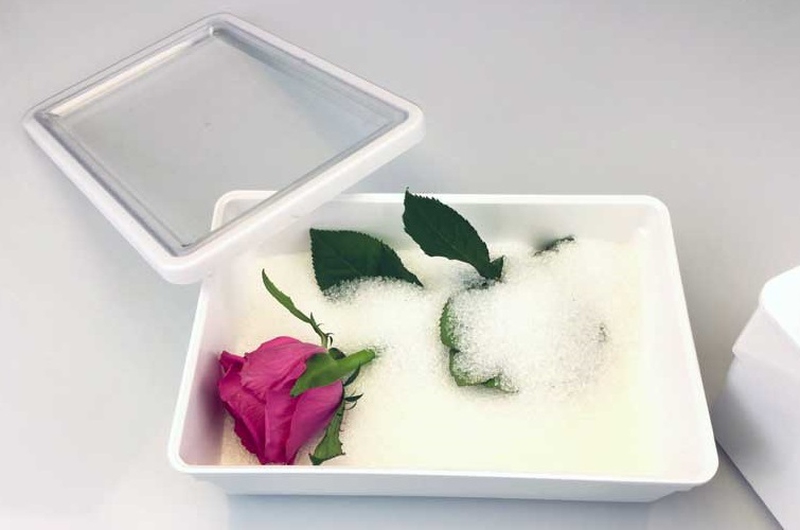So, it was your birthday and you received a lot more flowers and bouquets than you expected. Or it was V-day and your guy showered you with a lot more flowers than you could handle. Or these are your wedding flowers that you want to preserve forever, or you’re a craft crazy gal who loves to upcycle as much stuff as you can. Whatever your reasons, now you want to know how to dry flowers, and guess what? You’ve come to the right place!

Things to Know Before Drying Your Flowers
Think About flower types and drying methods
Don’t wait for your flowers to bloom to dry them. The more mature they are, the more likely they are to lose their petals in the drying process
If you have strong flowers like rose or lavender at hand, opt for air drying.
If you have delicate flowers like lilies, opt for pressing them.
If you have individual flowers like tulips or chrysanthemums, opt for drying them through the microwave.
Choose the drying location
Since the process of drying can take anywhere between 15 to 30 days, you have to choose your location well. Things to keep in mind include:
A location with little to no traffic or disturbance.
Away from the reach of pets, children and clumsy spouses.
Good ventilation, with an adequate supply of fresh air. Use a fan if ventilation isn’t good enough.
How to dry flowers quickly? Use a humidifier to hasten the process, especially if you live in a humid area.
Keep them away from direct sunlight, while also not shrouded in complete darkness. Direct sunlight pales the color of the dried flowers further. Dried buds also continue to blossom under direct sunlight.
Bedrooms, closets or attics work the best.
Kitchens and bathrooms should be avoided because of the level of humidity those places carry.
How to Dry Your Flowers
Try the pressing method
Ah, this one’s fairly simple but if you’ve never done it before, no issues.
First, find a very heavy book, like an old dictionary, encyclopedia or a telephone book.
Open it towards one of the last pages, and add a sheet of wax paper on both sides of the pages.
Arrange the flowers and make sure they aren’t place on top of each other.
Keep the book in a secure location, with its face up. This will ensure that the maximum weight of the pages is pushing the flowers.
After a week or so, open the book and check for progress. If they’ve dried, good! If not, leave them there for another week.
Use the silica gel method
Find an airtight container that can fit your flowers without breaking them or reshaping their form.
Pour enough silica gel that can give you a 2-3cm thick layer in the container.
Arrange your flowers inside the jar/container.
Then completely fill the remainder of the space in container with silica gel.
Make sure you do this slowly and carefully, because pouring the gel suddenly and all in one go will damage the blooms, especially if they’re small or delicate.
Fill from the sides first, and then shift to the middle of the container.
Keep shaking your container slightly so that the gel can settle at the bottom as well as the center, giving you an even layer every time.
Let it dry of at least 15-20 days.
Keep an eye on the flowers because if left surrounded by the gel for prolonged periods of time, they will become brittle and will break easily.
Try the microwave method
In a microwave safe container, pour 2 inches worth of silica gel.
Arrange your flowers, and then gently (using the guides mentioned above) add more gel till the flowers are covered.
Leaving the container covered, put it inside the microwave.
The next step in how to dry flowers is to microwave them at the lowest temperature you have, and do so for 2-3 minutes at first.
This method will require a lot of trial and error, mostly because of the type of flowers you have, so it’s best to do 3-4 trial runs with 1-2 blossoms each time.
Keep checking the state of your flowers.
Once dry, remove them, slightly open the container by half an inch, and let the flowers cool for 24 hours.
Your Checklist After You’ve Dried the Flowers
Now that you know how to dry flowers and you’ve dried the one you wanted to, it’s time for other things you should keep in mind!
Check if the flowers are dry: Take the smallest or the most deformed dried flower stalk that you can find, and snap off a piece from it. If it breaks easily, it’s dried.
You can also use a knife to puncture the bottom of the blossom. If that portion seems soft and squishy, you need to dry your flowers for a longer time.
Remember, this is a trial and error method, so don’t be too harsh on yourself for getting it wrong the first time.
If they have dried, separate them gently, check for deformations or damages, and cut off any unattractive parts.
If needed, spray with hairspray for protection.
And that’s it. You’re good to go!









View All Comments /Add Comment